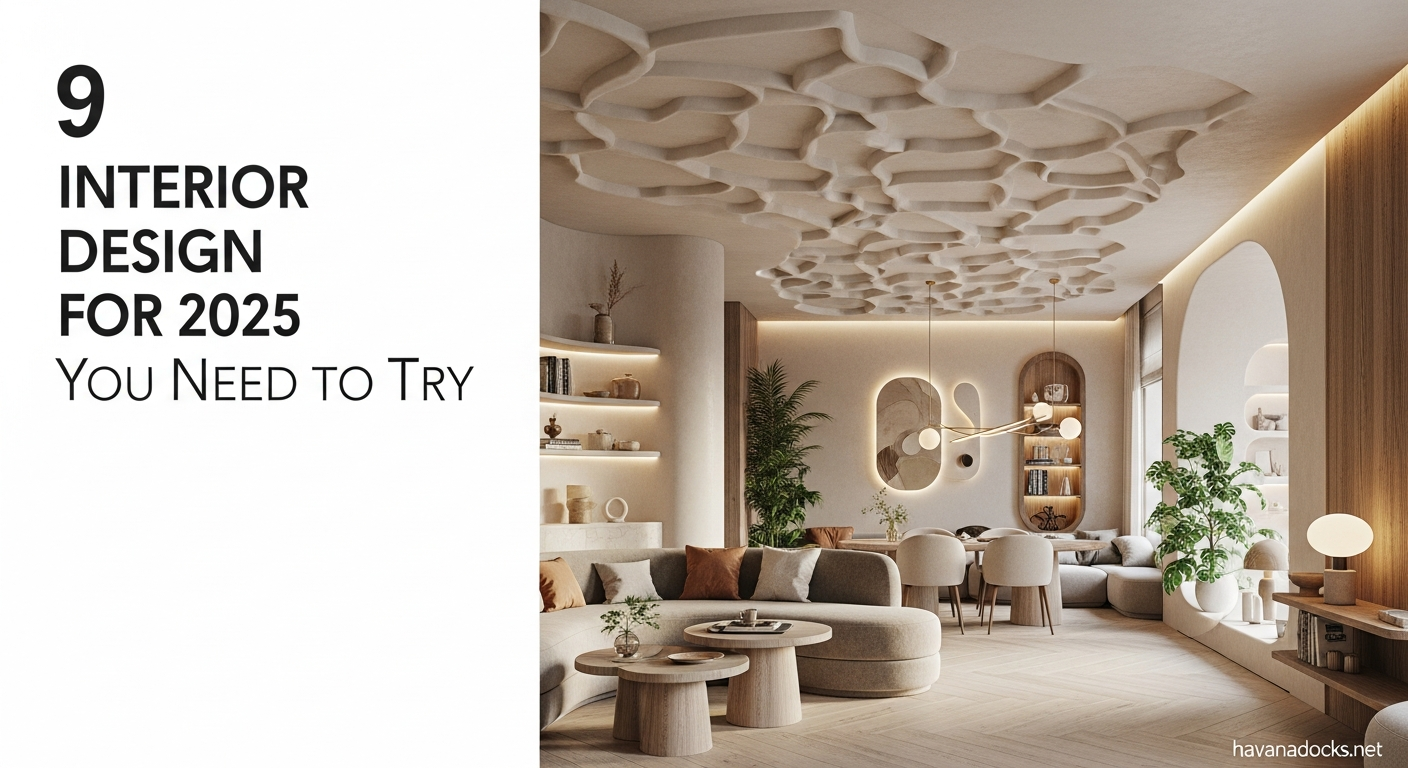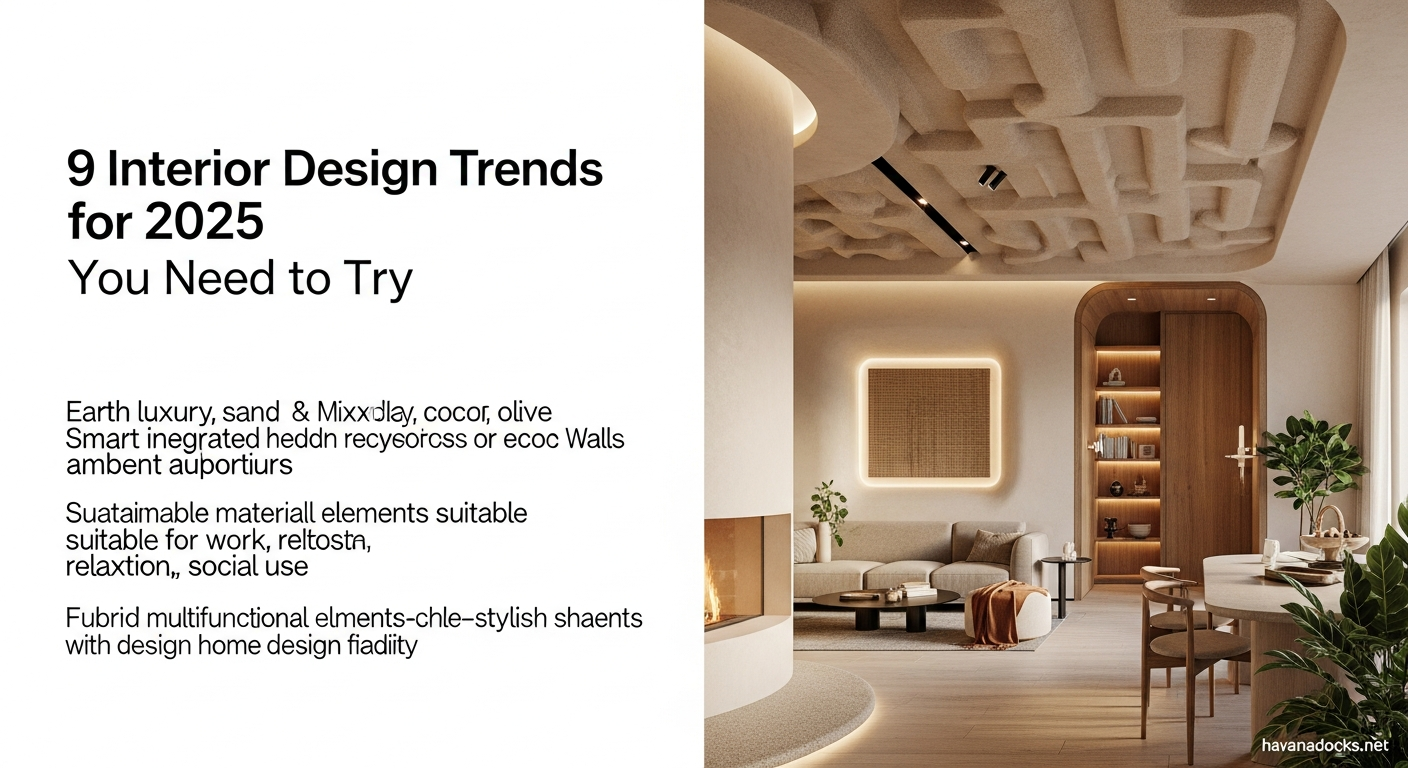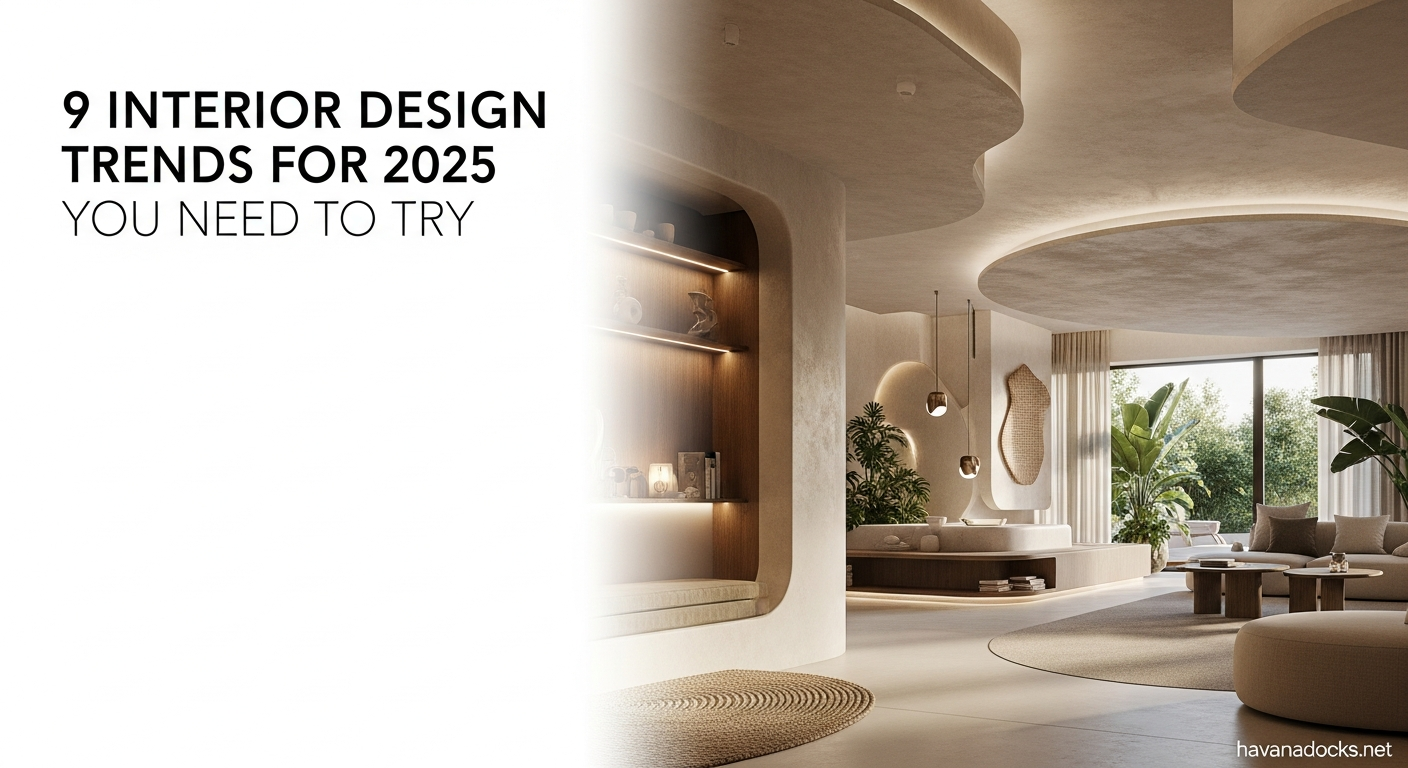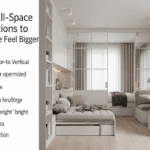Biophilic Bliss: Connecting with Nature
9 Interior Design – The yearning for a connection with nature continues to grow, making biophilic design a dominant force in Interior Design Trends 2025. This design philosophy emphasizes bringing elements of the natural world into our homes, fostering a sense of tranquility and well-being.
Lush Indoor Gardens
Forget simple potted plants; 2025 will see the rise of elaborate indoor gardens. Imagine vertical walls adorned with cascading greenery, miniature ecosystems thriving in repurposed containers, and even indoor trees creating a serene, forest-like atmosphere. These gardens not only add visual appeal but also improve air quality and reduce stress.
Natural Materials Reign Supreme
Expect to see a greater reliance on natural, sustainable materials like bamboo, rattan, cork, and reclaimed wood. These materials bring warmth, texture, and a sense of authenticity to interiors, aligning with the growing consumer demand for eco-conscious design choices.
Earth Tones and Organic Forms
Color palettes will draw inspiration from nature, featuring earthy tones like muted greens, warm browns, sandy beiges, and deep blues. These colors will be complemented by organic shapes and flowing lines, creating spaces that feel calming and harmonious. Think curved sofas, pebble-shaped coffee tables, and lighting fixtures that mimic natural forms.

The Rise of Smart Home Integration
Technology continues to permeate every aspect of our lives, and interior design is no exception. In Interior Design Trends 2025, smart home integration becomes seamless and intuitive, enhancing convenience, efficiency, and personalized comfort.
Voice-Activated Control
Voice assistants like Alexa and Google Assistant will play an even more prominent role in controlling various aspects of our homes, from lighting and temperature to entertainment and security. Imagine simply saying, “Dim the lights and play relaxing music,” and your home responds instantly.
Personalized Lighting Solutions
Smart lighting systems will offer unparalleled customization, allowing you to adjust the color temperature, brightness, and intensity of lights to suit different moods and activities. These systems can also be programmed to automatically adjust throughout the day, mimicking natural sunlight patterns and promoting better sleep.
Integrated Entertainment Systems
Say goodbye to cluttered entertainment centers. In Interior Design Trends 2025, entertainment systems will be seamlessly integrated into walls, ceilings, and even furniture. High-definition televisions will disappear behind artwork when not in use, and speakers will be discreetly embedded into the structure of the room.
Maximalist Magic: Embracing Bold Statements
While minimalism has dominated design for years, a counter-trend is emerging: maximalism. Interior Design Trends 2025 see a growing embrace of bold colors, eclectic patterns, and layered textures, creating spaces that are rich in personality and visual interest.
Vibrant Color Palettes
Forget muted tones; maximalism encourages the use of vibrant, saturated colors. Think jewel tones like emerald green, sapphire blue, and ruby red, combined with unexpected pops of neon or metallic accents.
Eclectic Pattern Mixing
Mixing and matching different patterns is a key element of maximalist design. Don’t be afraid to combine floral prints with geometric patterns, stripes with polka dots, or animal prints with abstract designs. The key is to create a sense of visual harmony through careful layering and coordination.
Bold Art and Statement Pieces
Maximalist interiors are showcases for art and unique statement pieces. Display your favorite paintings, sculptures, and collectibles prominently, creating a gallery-like atmosphere that reflects your personal style and interests.
The Comfort Cocoon: Prioritizing Well-being
In an increasingly stressful world, our homes are becoming sanctuaries where we can recharge and rejuvenate. Interior Design Trends 2025 prioritize comfort and well-being, creating spaces that feel cozy, inviting, and conducive to relaxation.
Soft Textures and Plush Fabrics
Imagine sinking into a plush velvet sofa, wrapping yourself in a soft cashmere blanket, or walking barefoot on a luxurious shag rug. Comfort is paramount in this trend, with an emphasis on soft textures and tactile materials.
Warm and Inviting Lighting
Harsh, bright lighting will be replaced by warm, diffused lighting that creates a sense of intimacy and relaxation. Think dimmable lamps, ambient lighting fixtures, and candles that cast a soft, flickering glow.
Dedicated Relaxation Zones
Create dedicated spaces for relaxation, such as a cozy reading nook with a comfortable armchair and a stack of favorite books, or a meditation room with calming colors, soft cushions, and soothing aromatherapy diffusers.

Multi-Functional Spaces: Adapting to Changing Needs
As our lifestyles become more fluid and flexible, the need for multi-functional spaces is growing. Interior Design Trends 2025 emphasize creating rooms that can easily adapt to different purposes, maximizing space and functionality. The year 2025 marks a shift toward homes designed not as static environments, but as dynamic living ecosystems that can respond to the evolving needs of their occupants. Flexibility is no longer considered a luxury—it has become a necessity.
One of the most significant developments is the rise of transformative layouts, where rooms can shift purposes within seconds. The growing popularity of compact homes and urban living has pushed designers to rethink how space is utilized. For example, a living room can turn into a complete home office with the help of foldable desks, sliding wall panels, or modular seating arrangements. Bedrooms are now equipped with beds that tuck seamlessly into the wall, revealing open floor space for personal workouts or creative projects. Smart modular furniture has become a key player in making these transformations possible.
Another major highlight is the expansion of hybrid spaces—areas designed to support multiple daily activities. Dining rooms now double as collaborative workspaces, craft studios, or study corners for children. Modern dining tables feature adjustable heights, hidden storage compartments, and durable surfaces to accommodate everything from laptop workstations to art supplies. This trend has grown from the increasing need for work-from-home (WFH) environments that remain relevant even as lifestyles slowly return to normal.
Technology integration is also shaping the evolution of multi-functional interiors. Smart lighting systems can shift from warm ambient tones during relaxation hours to bright, focus-oriented lighting for work sessions. Automated partitions are gaining popularity—movable, sound-absorbing dividers that increase privacy without requiring major construction work. These innovations allow homeowners to modify their surroundings with minimal effort.
Despite the emphasis on flexibility, the aesthetic direction of 2025 remains rooted in calming, minimalist design. Clean lines, soft earthy palettes, and natural materials like wood, bamboo, and stone dominate interiors. This design philosophy helps create a visually peaceful environment—important when multiple activities overlap within the same space. A well-designed multi-functional room should adapt to new tasks without disturbing the overall sense of harmony.
Another defining trend is the rise of built-in solutions. Designers are integrating storage directly into walls, floors, and architectural features to maintain a clutter-free look. Concealed cabinetry, push-open panels, wall-embedded foldable desks, and raised platforms with hidden compartments offer maximum storage without sacrificing aesthetics. These solutions are especially beneficial in small homes where every inch matters.
Additionally, the concept of zoning without walls has become increasingly popular. Instead of relying on physical barriers, designers use subtle techniques such as varying floor textures, accent lighting, or shifts in color to define different zones. This approach expands the perceived size of a room while adding visual depth and layering.
Overall, Interior Design Trends 2025 highlight the importance of creating homes that evolve alongside the people who live in them. Rather than being rigid, interiors are shifting toward responsive, versatile, and highly personalized environments. With the perfect blend of technology, smart furniture, and minimalist aesthetics, multi-functional design is set to redefine how we live, work, and relax in the modern home.
Convertible Furniture
Convertible furniture is a game-changer for small spaces. Think sofa beds, fold-away desks, and expandable dining tables that can be easily transformed to suit different needs.
Flexible Room Dividers
Room dividers, such as folding screens, curtains, or modular shelving units, can be used to create temporary walls and define different zones within a single room. This allows you to easily create a home office during the day and a cozy living room in the evening.
Vertical Storage Solutions
Maximize vertical space with tall shelving units, wall-mounted cabinets, and hanging organizers. This will help you keep your belongings organized and out of sight, creating a more spacious and uncluttered environment.
Sustainable Style: Eco-Conscious Choices
Sustainability is no longer a niche trend; it’s a fundamental value that is shaping Interior Design Trends 2025. Consumers are increasingly demanding eco-friendly products and practices, driving designers to prioritize sustainability in their projects.
Upcycled and Repurposed Materials
Give existing materials a new lease on life by incorporating upcycled and repurposed items into your designs. Think furniture made from reclaimed wood, lighting fixtures made from repurposed glass bottles, and décor items made from recycled textiles.
Locally Sourced Goods
Support local artisans and minimize your carbon footprint by sourcing materials and furnishings from nearby suppliers. This also helps to create a unique and personalized design that reflects the local culture and craftsmanship.
Energy-Efficient Appliances and Lighting
Invest in energy-efficient appliances and lighting systems to reduce your energy consumption and lower your utility bills. Look for products with Energy Star certifications and consider installing solar panels to generate your own renewable energy.
Retro Revival: Nostalgia with a Modern Twist
Nostalgia is a powerful force in design, and Interior Design Trends 2025 see a revival of retro styles from the 1970s and 1980s, but with a modern twist. This renewed interest in vintage aesthetics comes from a collective desire for comfort, familiarity, and emotional connection—elements that retro design delivers effortlessly. However, unlike pure restoration, the 2025 approach combines the warmth of the past with the functionality and elegance of contemporary living.
One of the most prominent influences returning from the 1970s is the warm earthy color palette. Shades like burnt orange, mustard yellow, olive green, and amber are making a comeback, but they are being reintroduced in more sophisticated and balanced ways. Instead of overwhelming a space with bold colors, designers are pairing these tones with neutral backgrounds and modern materials to create a harmonious blend that feels both nostalgic and fresh.
The 1980s revival, on the other hand, brings back geometric patterns, bold shapes, and playful contrasts. Iconic elements such as checkered tiles, rounded furniture silhouettes, and Memphis-style accents are resurfacing. But 2025’s version refines these features by softening the color intensity, simplifying the forms, and integrating them more subtly into modern layouts. The result is a retro-inspired aesthetic that feels chic rather than chaotic.
Another key trend is the return of vintage furniture with updated craftsmanship. Classic mid-century chairs, retro coffee tables, and curved sofas are being redesigned using sustainable materials, improved ergonomics, and contemporary finishes. This allows homeowners to enjoy the timeless charm of retro pieces while benefiting from today’s comfort and durability standards. Reupholstered vintage finds are also increasingly popular, especially among those seeking unique, character-rich pieces.
Texture plays a significant role in this retro resurgence. Velvet, corduroy, rattan, and natural wood grains are making their way back into living spaces, offering tactile richness and visual warmth. These textures balance perfectly with modern metals like brushed gold, matte black, and stainless steel—creating an intriguing contrast that embodies the old-meets-new design philosophy of 2025.
Lighting design is also heavily influenced by retro nostalgia. Globe pendant lights, smoked glass lamps, and brass fixtures evoke classic 70s and 80s vibes while maintaining modern energy efficiency and smart-home compatibility. Many homeowners are opting for statement lighting pieces that double as decor, enhancing the vintage charm of a room without overpowering it.
Another defining element of this trend is the rise of retro-inspired patterns on walls and textiles. Wallpaper featuring botanical prints, repeating geometric motifs, or soft gradients reminiscent of the 80s sunset palette is gaining popularity. Paired with sleek contemporary furniture, these patterns inject personality and a sense of history into any space.
Customization is also a major factor in the 2025 retro revival. Homeowners are increasingly blending modern minimalism with curated vintage pieces to create spaces that feel personal and expressive. The trend encourages creativity—mixing retro artwork with modern shelving, or pairing a 70s-style sofa with contemporary lighting and smart home technology.
Ultimately, the retro resurgence in Interior Design Trends 2025 is about reinterpreting the past through a modern lens. It celebrates the charm and warmth of earlier decades while embracing innovation, sustainability, and functional design. This thoughtful fusion creates interiors that feel nostalgic yet contemporary—spaces that tell a story, spark emotion, and invite a sense of comfort that transcends time.
Warm Earth Tones and Groovy Patterns
Think avocado green, mustard yellow, and burnt orange, combined with geometric patterns, shag rugs, and macramé wall hangings. However, these elements are updated with cleaner lines, more sophisticated color palettes, and higher-quality materials.
Curved Furniture and Sculptural Lighting
Curved furniture and sculptural lighting fixtures are also making a comeback, adding a touch of playfulness and sophistication to interiors. Think rounded sofas, oversized floor lamps, and sculptural coffee tables.
Bold Accents and Statement Pieces
Don’t be afraid to add bold accents and statement pieces to your retro-inspired space. Think vintage posters, colorful artwork, and quirky décor items that reflect your personal style.
The Japandi Influence: Harmonious Minimalism
Japandi, a blend of Japanese and Scandinavian design principles, continues to gain popularity in Interior Design Trends 2025. This style emphasizes simplicity, functionality, and natural materials, creating spaces that are both calming and aesthetically pleasing.
Clean Lines and Minimalist Decor
Japandi interiors are characterized by clean lines, uncluttered surfaces, and minimalist décor. The focus is on creating a serene and harmonious environment, free from distractions.
Natural Materials and Neutral Colors
Natural materials like wood, bamboo, and linen are essential to Japandi design. These materials are typically paired with a neutral color palette of whites, grays, and beiges, creating a sense of tranquility and warmth.
Functional and Thoughtful Design
Every element in a Japandi space is carefully considered for its functionality and purpose. Clutter is minimized, and storage is discreetly integrated into the design.

Digital Art Integration: Blurring the Lines
The line between art and technology is becoming increasingly blurred, and Interior Design Trends 2025 see the integration of digital art into our homes in new and exciting ways.
Interactive Art Installations
Imagine a wall-mounted display that reacts to your movements, creating a dynamic and ever-changing artwork. Or a digital canvas that displays a curated collection of digital art from around the world.
Projection Mapping and Immersive Experiences
Projection mapping can transform ordinary surfaces into canvases for digital art, creating immersive and engaging experiences. Imagine your walls coming to life with animated patterns, or your ceiling transforming into a starry night sky.
NFTs and Digital Collectibles
The rise of NFTs (non-fungible tokens) is opening up new possibilities for collecting and displaying digital art. You can showcase your digital collectibles on a digital frame, or even create a virtual gallery within your home.
Conclusion
These nine Interior Design Trends 2025 offer a glimpse into the future of home design, highlighting a shift towards greater comfort, sustainability, and technological integration. By embracing these trends, you can create spaces that are not only aesthetically pleasing but also functional, supportive, and reflective of your personal style. As you plan your next interior design project, consider how you can incorporate these elements to create a space that is both modern and timeless. Whether it’s incorporating biophilic elements, embracing smart home technology, or experimenting with bold colors and patterns, the possibilities are endless. The key is to find what resonates with you and create a space that you truly love. Remember to keep an eye on emerging Interior Design Trends 2025 to stay ahead of the curve and create a truly unique and inspiring living environment.





